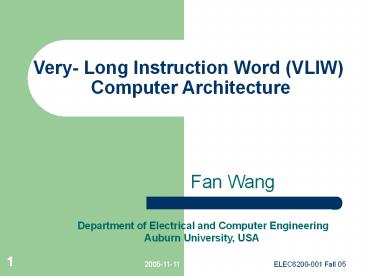Very- Long Instruction Word (VLIW) Computer Architecture PowerPoint PPT Presentation
Title: Very- Long Instruction Word (VLIW) Computer Architecture
1
Very- Long Instruction Word (VLIW) Computer
Architecture
Fan Wang
Department of Electrical and Computer
Engineering Auburn
University, USA
2
Background
- CISC (Complex Instruction Set Computing)
- instructions are quite complex and have variable
length. - a relatively small number of registers, and are
capable of accessing memory locations directly. - Complex instructions are sequenced in microcode
in modern CISC processors.
3
Cont.
- RISC(Reduced Instruction Set Computing)
- instructions are of fixed length and of a regular
format. - Operations are performed on registers only, of
which a larger number is available than on CISC
processors. The only memory operations are load
and store. - The hardware in RISC processors is simpler
because the RISC architecture relies more on the
compiler for sequencing complex operations.
4
The method for exploiting parallelism
- The key to higher performance in microprocessors
for a broad range of applications is the ability
to exploit fine-grain, instruction-level
parallelism - pipelining
- multiple processors
- superscalar implementation
- specifying multiple independent operations
per instruction
5
Problems we meet
- it is not easy to exploit parallel execution in
real programs, which are written in a serial
fashion. - Mainstream high-level languages (C and FORTRAN)
allow a limited freedom to execute operations in
parallel. - Programs need to be compiled into machine code,
but most conventional instruction sets do not
allow for the indication of parallel execution.
6
VLIW was invented
The idea of VLIW has been considered the work on
trace scheduling, a method of compiling programs
written in conventional languages for wide-word
machines, done by Josh Fisher in 1979 at Yale
laid down the foundation for VLIW technology. Now
John Fisher leads HPs VLIW compiler project.
VLIW Pioneer HP Senior Fellow Josh Fisher beside
his MultiFlow Trace VLIW machine, on display
at Computer History Museum.
7
Why VLIW ?
- To overcome the difficulty of finding parallelism
in machine-level object code. - In a VLIW processor, multiple instructions are
packed together and issued in parallel to an
equal number of execution units. - The compiler (not the processor) checks that
there are only independent instructions executed
in parallel.
8
Comparison of VLIW, CISC,RISC
9
VLIW characteristics
- VLIW contains multiple primitive instructions
that can be executed in parallel by functional
units of a processor. - The compiler packs a number of primitive,
non-interdependent instructions into a very long
instruction word - Since multiple instructions are packed in one
instruction word, the instruction words are much
larger than CISC and RISCs.
10
The VLIW compiler
- The compiler specifies the primitive instructions
per VLIW instruction word. - The compiler must guarantee that the multiple
primitive instructions which group together are
independent so they can be executable in
parallel. - Only the sequence of different VLIW words affects
the outputs (e.g., blue, red, green).
11
VLIW principle
12
VLIW principles
- 1.The compiler analyzes dependence of all
instructions among sequential code, tries to
extract as much parallelism as possible. - 2.Based on the analysis, the compiler re-codes
the piece of sequential code in VLIW instruction
words. - 3.Finally, the work left with VLIW hardware is
only fetch the VLIWs from cache, decode them, and
then dispatch the independent primitive
instructions to corresponding function units and
execute.
13
Implementation
- To get commercial success, Itanium was invented
instead of general purpose VLIW processor - A hypothetical VLIW processor architecture was
invented Instead of particular implementation
14
Generating of VLIW instruction words
A hypothetical VLIW processor architecture
15
- One VLIW instruction word contains maximum 8
primitive instructions. - Each time, one VLIW instruction word is fetched
from cache and decoded. - After decoding, all primitive instructions in
this VLIW word are issued to functional units in
parallel for execution. - These primitive instructions are from the same
VLIW word, so they are guaranteed to be
independent.
16
SOFTWARE INSTEAD OF HARDWARE IMPLEMENTATION
ADVANTAGES OF VLIW
- VLIW instructions explicitly specify several
independent operations decode the instruction
and dispatch hardware that tries to reconstruct
parallelism from a serial instruction stream. The
processor does not need to consider whether or
not the instructions are parallel.
17
Conclusion
- 1. The highly parallel implementation is much
simpler and cheaper than its counterparts. - 2. The encoding of VLIW words implies parallelism
among their primitive instructions, which results
in reduced hardware complexity. - 3. The complier must assemble multiple primitive
instructions into a single VLIW, to make sure
that multiple function units are kept busy.
18
Conclusion( cont.)
- 4. The compiler optimizes software pipeline by
re-ordering tries to find the most parallelism in
the sequential code. - 5. The microprocessor performance is dependent
on how the compiler produces VLIW words.
19
Relevant areas
- Trace Scheduling Algorithm, Dynamic Scheduling
- Explicitly Parallel Instruction Computing (EPIC)
- Dynamically Architected Instruction Set from
Yorktown (DAISY) - VLIW in Embedded Systems
20
References
- http//www.research.ibm.com/vliw/
- http//www.semiconductors.philips.com/acrobat_down
load/other/vliw-wp.pdf - http//www.unitedhpc.com/View_Docs/EPIC_VLIW.pdf
- http//www.cs.utah.edu/mbinu/coursework/686_vliw/
old/
21
- Thanks !

